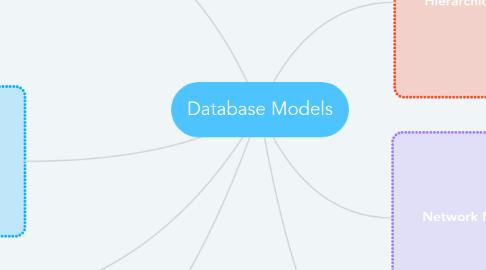
1. Entity relationship model
1.1. The Entity relationship models consist of and Entity Relationship Diagram
1.1.1. The diagram consists of entites
1.1.1.1. Used to model database components
1.1.1.1.1. Many versions of ERD exist including chen's notation, UML notation and crow foot's notation, etc.
1.1.2. Relationships between those entities
1.1.2.1. Consists of one-to-many relationships, one-to-one relationships and resolved many-to-many relationships
2. The object orientated model
2.1. The structure consists of an object that contains the data and their relationships
2.1.1. An example of a semantic data model
2.1.1.1. Consists of objects in classes, class methods, class hierarchy, and inheritance
2.1.1.2. Represents objects as a box
2.1.2. Used to represent real world objects
2.1.2.1. Amazon uses the object-orientated data model
3. NoSQL data model
3.1. Used to store unstructured or semi-structured data
3.1.1. Stores the data in key-value stores or in JSON documnets
3.1.1.1. Types of NoSQL databases include Document store, key-value store, graph store and column store
3.2. Solves the big data issue (demands and complexities)
3.2.1. Big data refers to ways to manage large amounts of data and derive business insight from it
3.2.1.1. Facebook and Amazon use NoSQL databases
4. XML databases
4.1. Supports the storage and management of semi-structured data
4.1.1. Used to manage data in some form or shape
4.1.1.1. IBM implements this database for their DB2. Microsoft SQL Server uses this type of database model too.
4.1.2. Used for data storage in complex relationships
4.1.3. Implementation ranges from middleware software, interfaces, to full XML database engines and Servers
5. Hierarchical Model
5.1. Records stored in tree structures
5.1.1. Structured like an upside-down tree
5.1.1.1. Handles large amounts of data
5.1.1.1.1. Used by Microsoft Windows OS for computer folders and Windows Registry
5.1.1.2. Used for complex manufacturing projects
5.1.1.2.1. Advantageous & Disadvantages
5.1.2. Data restricted to one parent entity that relates to multiple other entities
5.1.2.1. The hierarchical structure is of levels
5.1.2.1.1. Each level is the equivalent of a file system's record type
6. Network Model
6.1. The data is depicted in graph structures
6.1.1. Used to depict more complex data relationships efficiently to enhance database performance
6.1.1.1. Network models are not used today. But, Oracle implements this type of data model for their Spatial Topology
6.2. From user perspective, the data is collection of 1-to-many relatioships
6.2.1. Data not restricted to one parent entity. Data can have more than one parent.
6.2.1.1. Advantages & Disadvantages
6.2.1.1.1. Simple concept, ability to manage more relationships, Easy access to data
6.2.1.1.2. System Complexities, Functional Flaws, Lack of Structural Indepence
7. Relational Database Model
7.1. Consists of tables also called relations
7.1.1. Tables consist of rows & columns call records & attributes respectively
7.1.1.1. Used to store highly structured, predictable data
7.1.1.1.1. Can consist of one-to-many, one-to-one, and solved many-to-many relationships
7.1.2. Tables are related to each other through sharing of common attributes
7.1.2.1. Many different databases based on relational model today (SQL).
7.1.2.1.1. Microsoft uses relational database models for the Microsoft SQL server
